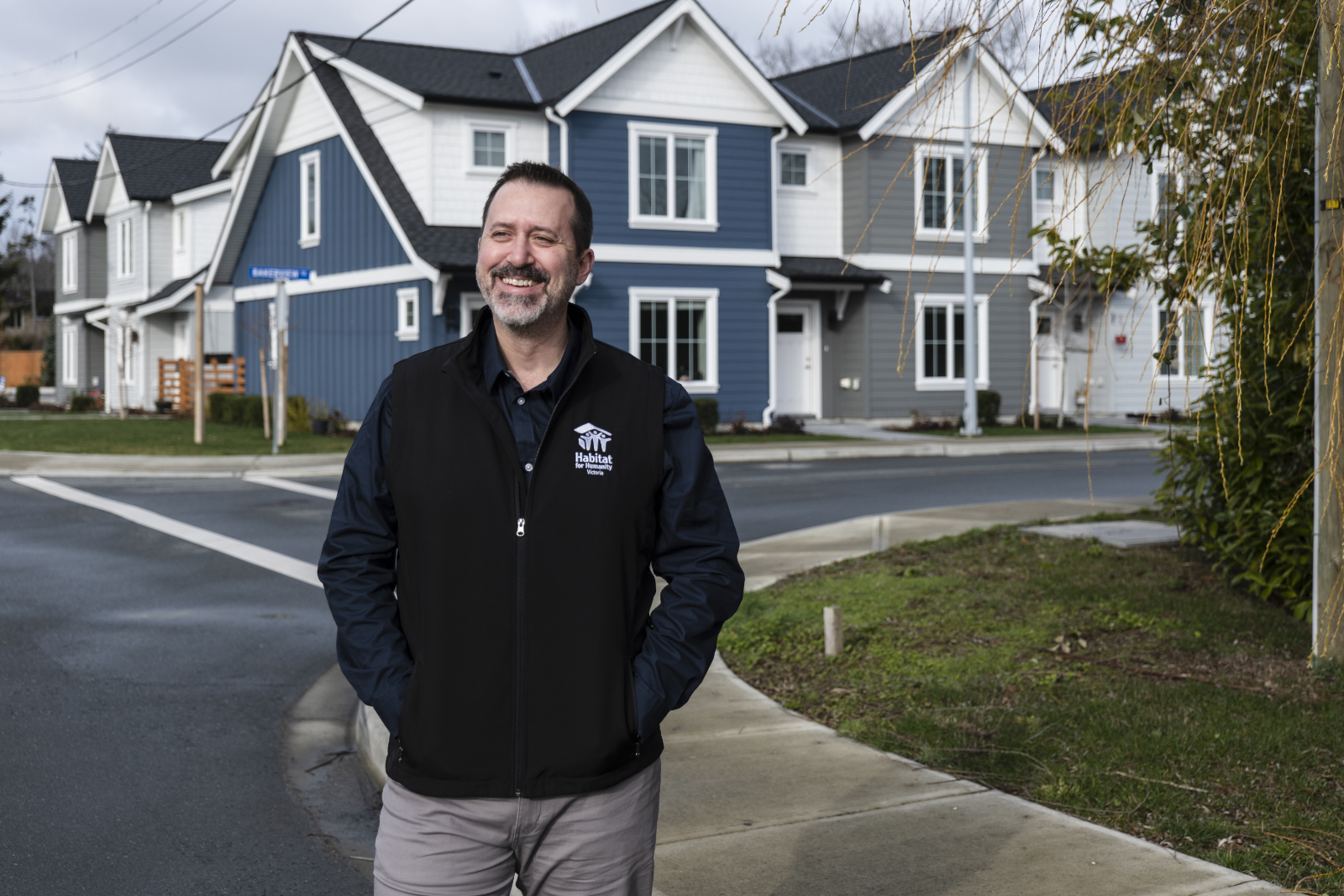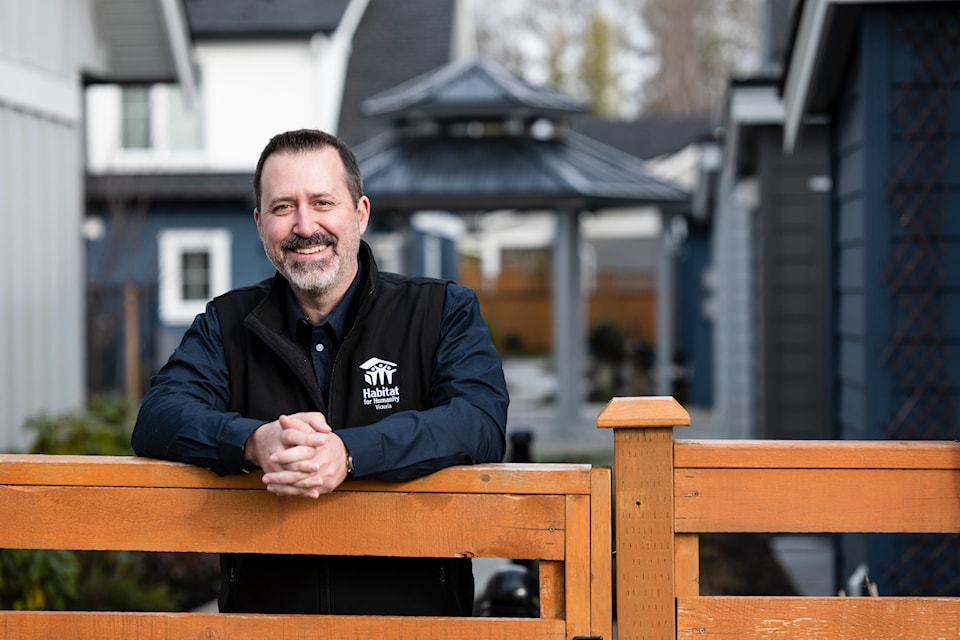Making an impact in his community is a role Scott Dutchak takes seriously.
Appointed CEO of Habitat for Humanity Victoria last fall, this former corporate real estate and development executive relishes overseeing an organization that connects with lower-income families at the grassroots level, works with them toward purchasing their own home, and helps alleviate the region’s housing crunch.
Compared to his previous state-of-the-art workplaces, Scott’s current digs are modest: his office sits above the Habitat ReStore in Langford, where on this day a steady stream of customers seeking discount home-renovation supplies come and go.
As he considered taking the job with Habitat, he recognized its goal to provide affordable homes via creatively funded, cooperative residential building projects dovetailed nicely with his belief that broadening the field of prospective home-buyers was of critical importance to society.
“Habitat has not given up on the dream, for many people, of actually owning your own home,” he says. “The fact there is still this glimmer of hope for homeownership really attracted me, and I think it’s really compelling for all Canadians to still have a bit of that dream. So, I said, ‘I can help make a difference,’ and jumped in with both feet.”
Drawing on his development experience, Scott has called for removal of municipal red tape – including limiting public consultation – as a way to streamline the process, reduce the cost of residential construction and make housing more affordable. He likes the so-called “missing middle” strategy, where neighbourhood infill projects make more efficient use of precious land.
While Habitat is between home-building projects, Scott is pursuing partnerships with municipalities, other non-profits, faith organizations and First Nations to find land on which to develop affordable home projects. He also encourages the public to consider legacy giving of property as another way to support Habitat initiatives.
Born in Newmarket, Ontario, the 50-year-old CEO comes from a family of civil engineers. He recalls how early conversations about highway and road construction got him interested in how cities grow, how people live together, travel, work and play.
He considered studying architecture but selected urban and regional planning.
“I think it was the right choice because urban planning really allowed me to explore both architecture and engineering, and think about urban systems and how people live together.”
The planning degree gave him three logical career paths – work for a municipal planning department, or become a consultant or developer. He chose the latter, feeling it presented the best option for him to make an impact in the community.
During his years in the development field, Scott liaised with municipal councils, residents and other community members, which afforded many opportunities to listen to others’ concerns and help find solutions. That role was particularly in focus during his recent stint as vice president of corporate real estate, sustainability and development for Telus.
Not surprisingly the $100-million Telus Ocean project, which he guided through to approval by Victoria council, stands out for him among his career accomplishments. The multipurpose office and retail centre, set to transform the high-profile corner of Humboldt and Douglas streets, was designed as a downtown hub for tech and innovation, a new home for Telus Victoria and a visible, practical and sustainably built boost to the city’s brand.
“As a citizen of Victoria keenly interested in the financial success and reputation of the city, I felt that it could make a huge difference,” Scott says.

So why step away from a successful development career to take on the top job with a non-profit?
Scott experienced what he calls a “been there, done that” moment as his work on Telus Ocean was winding down, and he wondered how else he could use his skills to have an impact in the community.
He was also tiring of the frequent back-and-forth travel to the mainland and wanted to spend more time with his active family.
He has enjoyed watching his 21-year-old daughter compete in heptathlon for UBC and shares a passion for motorcycling with his 19-year-old son, who currently studies at Vancouver Island University. Scott’s youngest son, 16, is an avid rower attending Claremont Secondary School.
As a member of the District of Saanich’s Housing Strategy Task Force in 2020-21, Scott became acutely aware of how the crisis of unaffordability is crushing the hopes of many area residents to buy a home. He worries about the possibility for his own children to one day attain homeownership.
With many homeowners in established neighbourhoods ardently clinging to the status quo – critics call them NIMBYs (“not in my backyard”) – Scott expects councils elected on housing promises will soon have tough decisions to make on development applications that push traditional limits around such factors as density, traffic impacts and tree preservation.
“Especially when we have this housing crisis, if we have a single person living in a single-family lot where you could otherwise accommodate six families, for example, what should win? I don’t know.”
Habitat for Humanity Victoria has developed such infill housing in the past and continues to seek similar opportunities around the capital region.
Despite being a registered charity, Scott points out Habitat does not receive any government funding and relies on public donations of cash, land, labour and materials to do its good works.
“We have a backlog of interest in our program,” he says of the applications for housing. “At the end of the day we want to do more and we have huge demand.”
Scott welcomes input and ideas for increasing the housing stock in Greater Victoria. He can be reached at ceo@habitatvictoria.com. Or visit habitatvictoria.com for more information.
This story first appeared in the spring 2023 edition of Boulevard Victoria.



